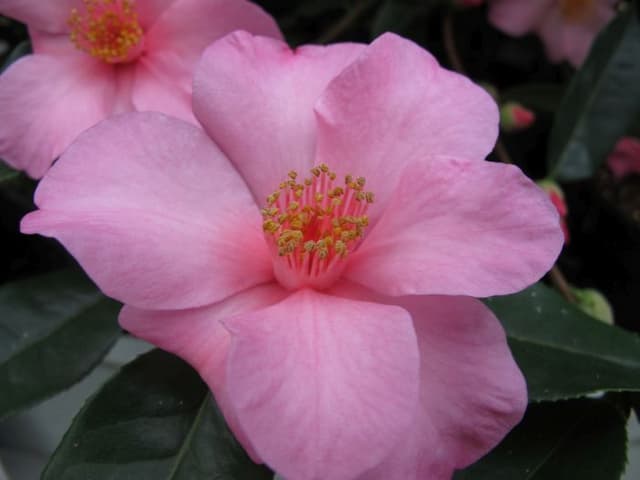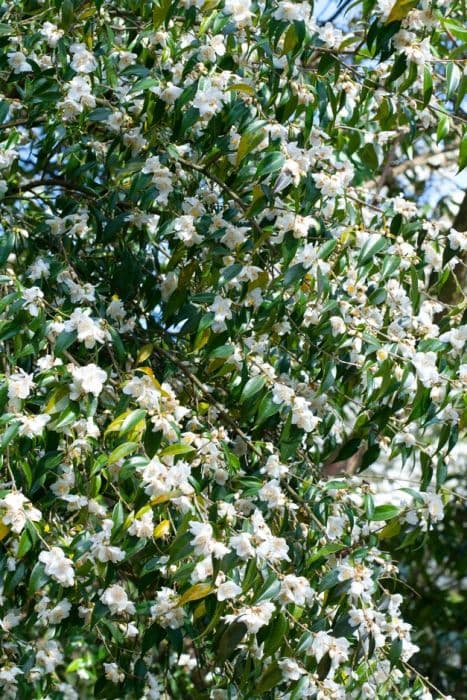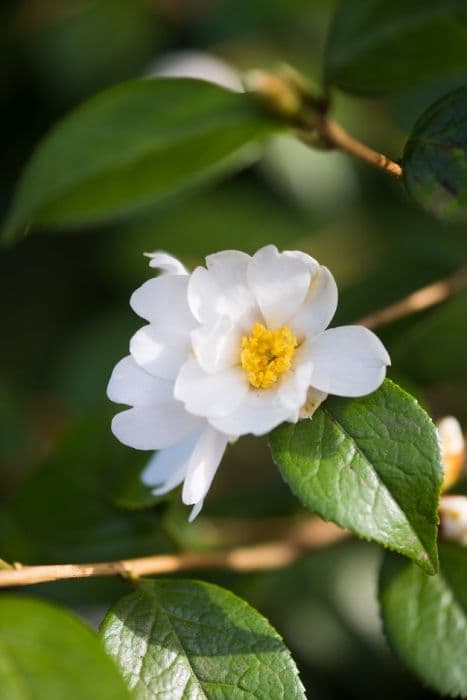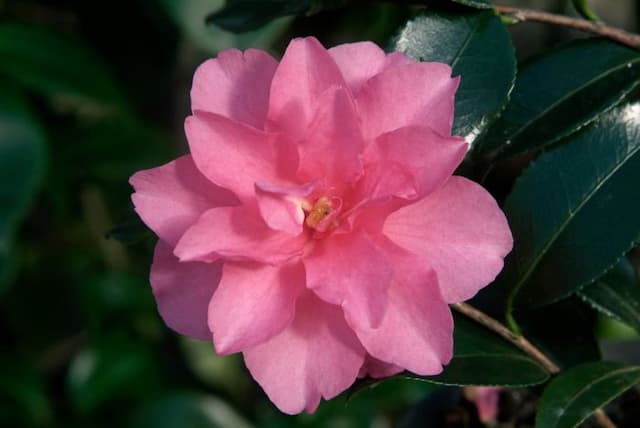Debbie Camellia Camellia × williamsii 'Debbie'

ABOUT
The plant known as 'Debbie' is a variety of Camellia notable for its attractive blooms and rich foliage. The flowers exhibit a captivating deep pink hue, often described as a peony form due to the arrangement of their petals, which are numerous and somewhat ruffled. This gives the flowers a lush, full look, bursting with color. The petals have a moderately glossy finish, adding a touch of sheen to the overall appearance of the bloom. Surrounding the flowers, the leaves of the 'Debbie' plant are dark green and glossy, creating a vivid backdrop that accentuates the pink blooms. These leaves are leathery to the touch and have a smooth-edge shape, which contrasts with the flowers' ruffled petal texture. The plant presents an evergreen characteristic, meaning the foliage remains throughout the year, providing consistent garden interest even when it is not in flower. Overall, the combination of the luxurious deep pink flowers and the shiny green foliage makes this particular Camellia a visually striking addition to a garden or landscape, offering a splash of vibrant color and textural contrast.
About this plant
 Names
NamesFamily
Theaceae.
Synonyms
Debbie Williamsii Camellia, Debbie Camellia.
Common names
Camellia × williamsii 'Debbie'
 Toxicity
ToxicityTo humans
The Camellia, specifically the 'Debbie' variety, is not typically considered toxic to humans. There are no widely recognized symptoms of poisoning from this plant, as it is generally not known for being harmful if ingested. Consequently, ingestion of parts of the Camellia 'Debbie' plant is not commonly associated with serious consequences for humans.
To pets
Camellia, including the 'Debbie' variety, is generally not considered toxic to pets either. It is not known to cause poisoning if pets ingest parts of the plant. Thus, the ingestion of Camellia 'Debbie' is not typically associated with adverse symptoms or significant health consequences for pets.
 Characteristics
CharacteristicsLife cycle
Perennials
Foliage type
Evergreen
Color of leaves
Green
Flower color
Pink
Height
6-12 feet (1.8-3.6 meters)
Spread
6-10 feet (1.8-3 meters)
Plant type
Shrub
Hardiness zones
7-9
Native area
Asia
Benefits
 General Benefits
General Benefits- Ornamental Value: 'Debbie' variety of Camellia has large, double, pink flowers that are aesthetically pleasing and add visual interest to gardens and landscapes.
- Long Blooming Season: It typically has a long flowering period from late winter to early spring, providing color during times when many other plants are dormant.
- Evergreen Foliage: As an evergreen shrub, it maintains its glossy, deep green leaves year-round, ensuring that gardens have continual foliage cover.
- Drought Tolerance: Once established, 'Debbie' Camellias can tolerate periods of dryness, making them suitable for gardens with occasional water restrictions.
- Shade Tolerance: This plant can thrive in partially shaded environments, where many other flowering plants may not perform well.
- Cold Resistance: It exhibits a degree of cold resistance, making it appropriate for planting in regions that experience cooler winters.
- Wildlife Attraction: The flowers can attract pollinators such as bees, while the dense foliage provides shelter for birds.
- Low Maintenance: 'Debbie' Camellias generally require minimal pruning and upkeep, making them convenient for gardeners of all skill levels.
- Versatility: They can be used in various landscape designs, including foundation plantings, borders, or as a specimen plant.
 Medical Properties
Medical PropertiesThis plant is not used for medical purposes.
 Air-purifying Qualities
Air-purifying QualitiesThis plant is not specifically known for air purifying qualities.
 Other Uses
Other Uses- Camellia 'Debbie' petals can be used to add a colorful touch to salads or as an elegant edible garnish, offering a mild taste and enhancing the aesthetics of dishes.
- The leaves of Camellia 'Debbie' can be used as a natural dye for fabrics, yielding various shades of green and brown depending on the mordant used.
- The fallen flowers can serve as a natural mulch, providing nutrients to the soil as they decompose and helping to retain soil moisture.
- The plant can be used as a living privacy screen or hedge when planted in a row, due to its dense foliage and fairly quick growth habit.
- Cut branches with buds and flowers can be used for indoor flower arrangements, bringing a touch of spring indoors and lasting several days in water.
- Camellia 'Debbie' can be utilized in bonsai cultivation due to its attractive flowers and leaves, providing a challenge for enthusiasts to create miniature representations of mature plants.
- Its dense, evergreen foliage offers a suitable shelter and nesting site for birds, enhancing the biodiversity of your garden.
- The wood of Camellia 'Debbie' is hard and durable, which, although not a common use, can be carved or turned into small wooden objects or tools.
- Camellia 'Debbie' can act as a companion plant in the garden, possibly helping to deter certain pests with its scent, although more research might be needed in this area.
- Photographers and artists can use Camellia 'Debbie' as a subject for their work, thanks to its vibrant flowers and attractive form, inspiring various forms of artistic expression.
Interesting Facts
 Feng Shui
Feng ShuiThe Williamsii Camellia is not used in Feng Shui practice.
 Zodiac Sign Compitability
Zodiac Sign CompitabilityThe Williamsii Camellia is not used in astrology practice.
 Plant Symbolism
Plant Symbolism- Adoration: Camellias often symbolize admiration and perfection, making 'Debbie' a way to express deep adoration and esteem for someone.
- Love: Given its beauty, the Camellia is frequently associated with romantic love, especially a love that is steadfast and true.
- Affection: The 'Debbie' variety, with its lush petals, can be seen as a symbol of deep affection and heartfelt emotion.
- Longevity and Faithfulness: Camellias are known for their long blooming season, thus symbolizing the enduring nature of love, suggesting a commitment that lasts over time.
 Water
WaterWilliamsii 'Debbie' camellias prefer consistently moist soil, so water them thoroughly when the top inch of soil feels dry to the touch. A good practice is to provide them with 1-2 gallons of water every week during the growing season, depending on rainfall and soil drainage. In hotter temperatures or windy conditions, water twice a week. During winter, reduce watering but do not allow the soil to completely dry out. Always water slowly at the base of the plant to ensure deep penetration to the roots and minimize leaf wetness.
 Light
LightWilliamsii 'Debbie' camellias thrive in partial shade, ideally receiving filtered sunlight or morning sun and afternoon shade. Avoid placing them in full sun, which can scorch their leaves, or deep shade, as this can result in fewer blooms. A spot that offers protection from harsh midday sun while allowing gentle morning light is perfect.
 Temperature
TemperatureWilliamsii 'Debbie' camellias grow best in temperatures between 50 to 70 degrees Fahrenheit but can tolerate brief dips down to around 10 degrees and highs up to 85 degrees without severe damage. They are cold hardy and can survive winter chill but should be sheltered from strong winds and extremely hot conditions.
 Pruning
PruningPrune Williamsii 'Debbie' camellias immediately after blooming, as they set next year's flower buds shortly thereafter. Pruning is necessary to maintain shape, remove dead or weak growth, and encourage airflow within the plant. Aim to prune once a year, focusing on thinning out crowded branches and cutting back any overly long shoots.
 Cleaning
CleaningAs needed
 Soil
SoilCamellia 'Debbie' thrives best in acidic to slightly acidic soil, with a pH of 5.5 to 6.5. An ideal soil mix for this plant would be a blend of equal parts peat moss, perlite, and pine bark. Additionally, well-draining soil is crucial, so incorporating a good amount of organic matter to retain moisture while avoiding waterlogging is recommended.
 Repotting
RepottingCamellia 'Debbie' should typically be repotted every 2-3 years to ensure it has enough room for root growth and to replace nutrient-depleted soil. Repotting is best done in late winter or early spring before the growing season begins.
 Humidity & Misting
Humidity & MistingCamellia 'Debbie' prefers moderate to high humidity levels to thrive. Aiming for a humidity level around 50-60% would be ideal for this plant. Maintaining these conditions will support its overall health and blooming potential.
 Suitable locations
Suitable locationsIndoor
Place in bright, indirect light and keep soil slightly moist.
Outdoor
Partial shade, sheltered location, well-draining acidic soil.
Hardiness zone
7-9 USDA
 Life cycle
Life cycleThe hybrid camellia 'Debbie', a cross between Camellia japonica and Camellia saluenensis, begins its life cycle as a seed which germinates in a warm, moist environment after a period of stratification. The seedling emerges, producing its first true leaves and establishing a root system over several weeks to months. As the plant matures, it enters a vegetative growth phase, steadily increasing in size and developing woody stems; this stage can last for several years before it reaches maturity. Once mature, 'Debbie' produces large, rose-pink, peony-like flowers, typically in late winter to early spring, attracting pollinators with its showy blossoms. After pollination, the flowers develop into seed capsules, which upon maturing, release seeds to start the next generation. With proper care including adequate water, fertilizer, and pruning, 'Debbie' camellias can live for many decades, continuing their cycle of growth, bloom, and seed production.
 Propogation
PropogationPropogation time
Early Spring
Camellia × williamsii 'Debbie', commonly known as Debbie Camellia, is typically propagated by semi-hardwood cuttings taken in late summer or early autumn. To propagate the Debbie Camellia, one selects healthy, semi-hardwood stems from the current year's growth that have started to mature but are not overly hardened. The cutting should be about 4 to 6 inches (approximately 10 to 15 centimeters) long and include several sets of leaves. The lower set of leaves is removed, and the cut end may be dipped in rooting hormone to improve chances of success. The prepared cutting is then inserted into a pot filled with a mixture of peat and perlite or sand to ensure good drainage and aeration. The pot is kept in a humid environment, ideally with bottom heat of about 70°F (approximately 21°C), and the soil should be kept consistently moist but not soggy until roots have developed, which can take several weeks to a few months.









